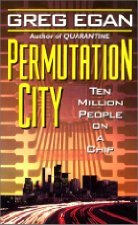Tomislav's Reviews > Permutation City
Permutation City
by

by

I recently read Neal Stephenson's 2019 novel Fall, or Dodge in Hell concerning the economics and politics of the creation of a cybernetic synthetic world, and the lives of characters after they move into it. I wish I had read Greg Egan’s Permutation City instead. It predates Fall by 25 years, and yet is more current, more insightful, and more cerebrally engaging. Don’t be like me; read Permutation City first.
Greg Egan is an Australian hard science fiction writer, whose stories often involve mathematics, physics, biology, and ontology themes such as the nature of consciousness. Permutation City (1994) was one of his earliest published novels, and sometimes numbered as second in his Subjective Cosmology series. The others are Quarantine (1992) and Distress (1995), both worth reading, but truly they are each completely stand-alone, and related only thematically. Parts of Permutation City were adapted from Egan's 1992 short story "Dust.” The novel won the John W. Campbell Award and Ditmar Award in 1995.
The plot follows the lives of several people in a near future reality where the Earth is ravaged by the effects of overdevelopment, and humans live in a globalized culture and economy. Vast amounts of computing resources are available, sufficient to host virtual reality worlds for copies of dead or dying wealthy individuals, and bottom-up cellular automaton worlds. The four perspective characters are Paul, an insurance salesman and immortal virtual life visionary, Maria, a software engineer he hires to build the simulation for his speculative supercomputer, Thomas, a wealthy customer of Paul’s with a sordid secret in his past, and Peer and Kate, lovers who illicitly stow away in the simulated world, living in threaded bits of unused processing capability throughout the program. “Dust Theory” holds that all potential universes, even those formed by tracing cause-and-effect non-sequentially through particles existing for other universes, do exist.
I found the concepts to be nearly as challenging as in non-fiction reading of science and/or philosophy. One chapter I had to read twice (Chapter 17) and ponder before proceeding. The chapter starts with dialog AFTER Paul has just finished explaining the complex topology of his story line to Maria, weaving together the alternating 2045 and 2050 threads for the first time. I coin the phrase anti-infodump – it is the absence of a conceptual infodump where one would have been useful. Readers must infer the infodump contents on their own.
It has been a long time since I described one of my reads as “mind-blowing,” but this one deserves it. Highly recommended.
Greg Egan is an Australian hard science fiction writer, whose stories often involve mathematics, physics, biology, and ontology themes such as the nature of consciousness. Permutation City (1994) was one of his earliest published novels, and sometimes numbered as second in his Subjective Cosmology series. The others are Quarantine (1992) and Distress (1995), both worth reading, but truly they are each completely stand-alone, and related only thematically. Parts of Permutation City were adapted from Egan's 1992 short story "Dust.” The novel won the John W. Campbell Award and Ditmar Award in 1995.
The plot follows the lives of several people in a near future reality where the Earth is ravaged by the effects of overdevelopment, and humans live in a globalized culture and economy. Vast amounts of computing resources are available, sufficient to host virtual reality worlds for copies of dead or dying wealthy individuals, and bottom-up cellular automaton worlds. The four perspective characters are Paul, an insurance salesman and immortal virtual life visionary, Maria, a software engineer he hires to build the simulation for his speculative supercomputer, Thomas, a wealthy customer of Paul’s with a sordid secret in his past, and Peer and Kate, lovers who illicitly stow away in the simulated world, living in threaded bits of unused processing capability throughout the program. “Dust Theory” holds that all potential universes, even those formed by tracing cause-and-effect non-sequentially through particles existing for other universes, do exist.
I found the concepts to be nearly as challenging as in non-fiction reading of science and/or philosophy. One chapter I had to read twice (Chapter 17) and ponder before proceeding. The chapter starts with dialog AFTER Paul has just finished explaining the complex topology of his story line to Maria, weaving together the alternating 2045 and 2050 threads for the first time. I coin the phrase anti-infodump – it is the absence of a conceptual infodump where one would have been useful. Readers must infer the infodump contents on their own.
It has been a long time since I described one of my reads as “mind-blowing,” but this one deserves it. Highly recommended.
Sign into Goodreads to see if any of your friends have read
Permutation City.
Sign In »
Reading Progress
March 16, 2018
– Shelved
March 16, 2018
– Shelved as:
to-read
March 16, 2018
– Shelved as:
science-fiction
January 12, 2020
–
Started Reading
January 17, 2020
– Shelved as:
5-stars
January 17, 2020
–
Finished Reading




Into a mute crypt, I
Can't pity our time
Turn amity poetic
Ciao, tiny trumpet!
Manic piety tutor
Tame purity tonic
Up, meiotic tyrant!
I taint my top cure
To it, my true panic
Put at my nice riot
To trace impunity
I tempt an outcry, I
Pin my taut erotic
Art to epic mutiny
Can't you permit it
To cite my apt ruin?
My true icon: tap it
Copy time, turn it; a
Rite to cut my pain
Atomic putty? Rien!
Found in the memoy of a discarded notepad in the Common Room of the Psychiatric Ward, Blacktown Hospital, June 6, 2045.